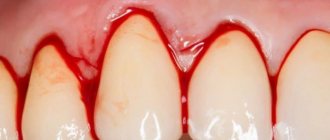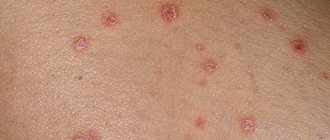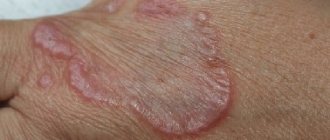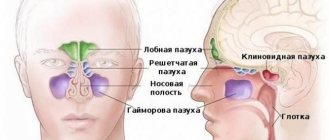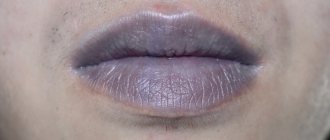Causes of gingivitis
The most common cause of gingivitis is poor personal oral hygiene. Violation of the rules may consist of inappropriate technique, irregular brushing of teeth, refusal to use dental floss and rinses after meals. As a result, food particles accumulate between the teeth, and a large amount of soft plaque forms on the surface of the teeth. This is a favorable environment for the proliferation of bacteria, which leads to the inflammatory process.
Soft plaque, which is not removed for a long time, mineralizes and hardens over time. When tartar appears, pathogenic microorganisms also actively multiply on it. In addition, the sharp edges of hard deposits injure the gum margin, which reduces local protective factors.
There are other common local causes of gingivitis:
- unsound orthopedic, orthodontic structures: braces with sharp edges,
- chips of enamel, destruction of teeth and fillings: injury to mucous membranes with sharp edges;
- teething disorders, dental caries, pulpitis, periodontitis, abscesses and other diseases;
Systemic pathologies and certain conditions can lead to the development of gum inflammation. The most common ones are:
- endocrine diseases - diabetes mellitus, Graves' disease, etc.;
- diseases of the digestive system - gastroesophageal reflux, Crohn's disease, chronic cholecystitis, etc.;
- hypovitaminosis, lack of minerals due to a strict diet or impaired absorption of nutrients;
- taking certain medications - antidepressants, local vasoconstrictors, antibiotics, combined contraceptives, beta-blockers, etc.;
- past infections and surgical interventions;
- puberty, pregnancy, menopause - changes in hormonal status not associated with illness;
- allergic reactions to food, medicines, hygiene products;
- bad habits.
Often there is a combination of factors - a combination of local and general causes of weakening of immune forces. You can find out the exact reasons only with the help of a doctor.
Ask a Question
Hypertrophic gingivitis –
Hypertrophic gingivitis is a variant of chronic gum inflammation.
With it, there is an increase in the volume of the gums, which can occur either due to persistent chronic swelling of the gums (which practically does not respond to anti-inflammatory therapy), or due to its fibrous growth. The hypertrophic form of gingivitis most often occurs only on the front surface of the teeth. Causes of occurrence - most often occurs with endocrine disorders, toxicosis of pregnant women (gingivitis of pregnant women), with hormonal changes in adolescents (juvenile gingivitis), as well as with malocclusion and in the presence of local traumatic factors - overhanging edges of fillings and crowns. In some cases, gum hypertrophy is a consequence of long-term chronic catarrhal gingivitis.
Hypertrophic form of gingivitis: photo
Hypertrophic gingivitis - symptoms and treatment will depend on the form of this disease, i.e. depending on what exactly causes the gum enlargement (edema or fibrous growth). In accordance with this, edematous and fibrous forms of hypertrophic gingivitis are distinguished.
- Edema form (Fig. 16-17) - the gingival papillae in this form are enlarged not due to tissue proliferation, but due to their swelling.
Accordingly, they will not be dense, but loose. It is this form of gingivitis that most often develops in pregnant women and adolescents against the background of hormonal changes. At the beginning of treatment, it is necessary to remove dental plaque and anti-inflammatory therapy. If the effect of these measures is insignificant, then sclerosing therapy is used, when, against the background of pain relief, a sclerosing solution is injected into the swollen gingival papillae. Typically, solutions of 40% glucose, 25% magnesium sulfate, 10% calcium chloride are used. 0.1-0.2 ml of solution is injected into each papilla. Course – 3 or 4 injections into each gingival papilla. The intervals between series of injections are usually 1-2 days. If the effect of such therapy is absent or insufficient, prednisolone is injected into the gingival papillae.
- Fibrous form (Fig. 18, 19) - the gingival papillae in this form are dense, and not loose as in the edematous form. This is due to the fact that the increase in gum volume did not occur due to swelling, but due to the proliferation of fibrous connective tissue. Treatment begins with the elimination of traumatic factors (overhanging edges of fillings, crowns, and also in the case of a traumatic bite - selective grinding of teeth). At the same time, dental plaque is removed.
The main method of treating the fibrous form is surgical excision of gum tissue (Fig. 19-21). After excision, a course of anti-inflammatory therapy is prescribed, for example, therapeutic dressings with heparin ointment, hydrocortisone and other drugs. It should be noted that in the absence of treatment, the long-lasting edematous form of hypertrophic gingivitis can easily turn into fibrous.Surgical excision of the gum –
Symptoms and consequences
Symptoms of gingivitis are determined by stage. The disease can begin with the following manifestations:
- swelling, redness, looseness of the gums;
- increased sensitivity of tissues, bleeding during brushing teeth and eating due to fragility of blood vessels;
- pain when chewing and touching;
- bad breath.
As the disease progresses, the necks of the teeth may become exposed, which leads to increased sensitivity of the teeth - it becomes difficult to accept hot and cold drinks and foods. The pain also increases over time, and severe difficulty chewing food may occur. In addition to general symptoms, there are also specific ones characteristic of a particular type of gingivitis.
The consequences of gum inflammation can be very serious: the pathological process often spreads to the ligamentous apparatus of the tooth, and periodontitis occurs. This condition is dangerous due to the mobility of teeth and the high probability of their loss. A chronic focus of inflammation in the mouth is a risk factor for the development of diseases of the ENT organs.
Gingivitis in adults: causes of the disease
The disease, which affects all categories of people (children, adults, pregnant women), occurs primarily due to weakened immunity and poor oral hygiene.
The development of the inflammatory process occurs at a low speed, so the disease is often not noticeable for a long time to an ordinary person who is far from dentistry. However, if you do not consult a doctor in a timely manner, serious complications may develop, which can lead to a more painful course of the disease and lengthy treatment.
There are three stages of development of gingivitis:
- mild (the disease affects only the spaces between the teeth);
- medium (the disease affects the edge of the gum);
- heavy.
The more time passes without treatment, the further the lesion spreads, eventually covering the oral mucosa.
The causes of the disease are divided into internal and external.
External ones include:
- injuries;
- burns of the oral cavity;
- influence of radiation;
- effects of heavy metals on the human body.
The internal reasons are as follows:
- development of molars (often during their growth, soft tissues are injured, which causes bleeding);
- lack of vitamins and minerals in the diet, which leads to decreased immunity;
- gastrointestinal diseases;
- various infections;
- neglected carious formations.
Types of gingivitis
Gingivitis can be acute or chronic. In the first case, noticeable symptoms occur. Chronic forms are characterized by mild symptoms, pain is absent or minimal. Periodic slight bleeding of the gums during brushing and halitosis may occur. It is important to understand that sluggish gingivitis is characterized by periodic exacerbations.
Inflammation of the gums is classified not only by its form, but also by the nature of its course.
Catarrhal gingivitis
Catarrhal gingivitis is characterized by redness of the gum area. Itching and bleeding due to mechanical action and mild pain may occur. This is the most common and easiest to treat type of inflammation. Quite often it acts as the initial stage of development of other forms.
Ulcerative gingivitis
Necrotizing ulcerative gingivitis is characterized by the formation of open ulcers, death of areas of gum tissue, and strong bad breath. One of the typical symptoms is the appearance of a grayish coating. The disease is more difficult to treat; in the absence of timely assistance, purulent foci and severe necrosis may appear.
Hypertrophic and atrophic gingivitis
Ulcerative-necrotic gingivitis is followed by hypertrophic gingivitis - excessive growth of tissues occurs that cover the crowns of the teeth. There is keratinization of areas of the gums.
The atrophic form of the disease, on the contrary, is characterized by a decrease in the level of the gums and exposure of the necks of the teeth. This condition is dangerous due to the loss of healthy teeth.
Desquamative gingivitis
This type of inflammation is characterized by abundant desquamation of the gum epithelium. Distinctive features are pronounced redness and noticeable peeling areas of the surface of the mucous membranes.
Gums are normal
Normal gums have a characteristic appearance. It is convenient to describe it using several simple criteria:
| Sign | Norm |
| Color | Pale pink, coral, salmon (if we are talking about fair-skinned people) |
| Surface | Lumpy (“lemon peel”) |
| Circuit | Pointed or trapezoidal interdental papillae |
| Consistency | Dense |
| Bleeding | No |
A few words about each of the criteria:
Gum color
The color of the gums is noticeably different from the color of the mucous membrane of the alveolar process. The alveolar mucosa is more red, smooth and shiny. All due to the characteristics of its epithelium and connective tissue:
— the epithelium of the mucous membrane of the alveolar process is thin, non-keratinizing, there are no epithelial outgrowths;
- looser connective tissue contains more blood vessels.
(you can read more about the structure of the gums in the article “Structure of the periodontium”)
The black arrow indicates the gums, the white arrow indicates the mucous membrane of the alveolar process.
Gum surface
A lumpy surface is characteristic of the attached gingiva (the marginal gingiva is smooth). Microscopically, these are gingival depressions (arrows in the figure) and elevations due to the different arrangement of the connective tissue layer.
Gum contour
The contour, or shape of the edge, of the gum may be different. It can be more flat or, conversely, arched on the vestibular and lingual sides. This depends on the shape and inclination of the tooth crown: the more convex the crown, the greater its inclination, the more pronounced the curvature of the gums.
The gum contour is flatter in the upper central incisors, more curved in the canines.
The interdental papillae are also different in shape: the less space there is for them (the teeth are denser), the “sharper” they are; the more, the, on the contrary, they are wider:
Wide interdental papilla Pointed narrow interdental papilla
Gum consistency
Healthy gums are dense in consistency. This is all thanks to the abundance of strong collagen gingival fibers in its connective tissue.
Gingival fibers
Bleeding gums
There are also vessels there that are not pathologically changed. That is why there is no bleeding of the gums when brushing your teeth at home or probing them by a dentist.
| Gum probing |
Now let's figure out how the gums change when inflammation occurs - gingivitis. First of all, why does it arise?
Diagnostic features
Gingivitis can be recognized visually—sometimes one examination by a doctor is enough. But you should make sure that there are no more serious pathologies, so diagnosis may include not only a visual assessment of the condition of the oral cavity, but also other measures:
- collecting anamnesis, assessing the condition of structures in the oral cavity;
- probing of periodontal pockets if present;
- determination of tooth mobility;
- electroodontodiagnosis to determine the condition of the dental pulp;
- panoramic x-ray or targeted x-ray - to exclude periodontitis, periostitis and other pathologies of deep structures, jaw bone tissue, etc.
It is important to take into account the presence of chronic diseases and medications. Only with complete information can a doctor make an accurate diagnosis and develop an effective treatment regimen.
Gingivitis - classification
Based on the form of the disease and the nature of its course, acute and chronic gingivitis is distinguished.
- The acute form begins with noticeable redness and bleeding of the gums. They swell and the interdental papillae enlarge.
- The chronic form is not so obvious, but the pathological process leads to the growth of gingival tissue and its “creeping” onto the tooth.
Depending on the type of inflammatory process, gingivitis occurs:
- Catarrhal
— exudative processes predominate, fluid is released from hyperemic gum tissue. There is a burning sensation in the oral cavity, there is heavy plaque on the teeth, and the papillae are swollen.
- Hypertrophic
— proliferative processes (tissue proliferation) predominate. In turn, hypertrophic gingivitis comes in two forms - edematous and fibrous. In the first form, the gums bleed and are painful, and in the second form, the gums are dense and no bleeding is observed.
- Ulcerative-necrotic
- the process goes deeper into the periodontal tissue, causing, in addition to pain and bleeding, ulceration of the gums. The general condition suffers, the lymph nodes enlarge. If left untreated, this type of gingivitis can develop into Vincent gingivitis, which affects the entire mouth.
Dentists also distinguish mixed varieties of the disease.
Principles of treatment
Treatment of gingivitis begins with hygiene: professional teeth cleaning. It is important to remove soft and hard dental plaque. For this, hand tools, an ultrasonic scaler, and the powder blasting method can be used. Subgingival dental plaque can be removed using the Vector device.
It is important to eliminate foci of infection - to fill teeth affected by caries, to undergo endodontic treatment in the presence of pulpitis, to remove the roots of teeth that cannot be restored and are not involved in the prosthetic process.
It is necessary not only to pay attention to the causes of the disease, but also to reduce the influence of harmful factors:
- stop smoking;
- consume food and drinks only at a comfortable temperature;
- remove spicy and smoked foods, marinades, especially those with vinegar, from the diet;
- During the treatment period, try to eat less solid food so as not to injure the loose gum tissue.
If the source of injury to the mucous membrane is the sharp edges of teeth or dentures, the doctor will immediately take measures to prevent further damage or recommend contacting a dentist of another profile - an orthopedist, an orthodontist.
Necrotizing ulcerative gingivitis: symptoms and treatment in adults
The cause of the disease, as in the previous case, is non-compliance with hygiene, which has taken a critical form.
Due to the increase in plaque volume, gum necrosis develops. This often occurs against the background of decreased immunity or exacerbation of chronic diseases.
The first sign of ulcerative necrotic gingivitis is areas of ulceration on the gums and an increase in temperature to 39 degrees. Headaches and smell of rotting breath are possible.
This form of the disease should be treated by a dentist, and on an emergency basis. Dental plaque is removed along with the gray-greenish plaque, strong antibiotics are prescribed, then, when the inflammation subsides, gels are prescribed to accelerate the healing and restoration of the mucous membrane.
Drugs for the treatment of gingivitis
Treatment for gingivitis may involve the use of medications in different forms. Mouth rinses based on antiseptics allow you to solve two problems at once: mechanically remove food debris and bacterial plaque, and also deliver active ingredients to inflamed tissues. Dentists recommend using ready-made pharmaceutical products; in each specific case, a specialist will prescribe a medicinal solution to quickly alleviate the condition. Ready-made formulations are more convenient to use, and the concentration of active components in them is known, this distinguishes them from traditional methods.
The most popular are rinses based on the following antiseptics:
- chlorhexidine;
- furacillin;
- chlorophyllipt;
- Metronidazole.
Calendula, chamomile, yarrow, oak bark, and St. John's wort have antiseptic properties. Doctors do not recommend preparing alcohol infusions; it is better to choose decoctions. The recipes call for using one teaspoon of dry raw materials per glass of boiling water. It is important to cool the broth to a comfortable temperature. Take into account possible allergic reactions, give preference to those herbs to which there was no previous intolerance. It is necessary to discuss with your doctor the possibility of using traditional methods.
Effective drugs for the treatment of gingivitis are ointments and gels. Multicomponent local products for applications not only help relieve inflammation, but also have an analgesic, decongestant, and antipruritic effect. The active components of such drugs can be lidocaine, antibacterial, antifungal substances, and antiseptics. The doctor will select a gel or ointment taking into account the shape and type of gingivitis. Thus, for ulcerative inflammation, it may be advisable to use regenerating agents, and acute catarrhal gingivitis will require the use of a powerful anesthetic gel.
For hypertrophic gingivitis, surgery may be required - a simple gingivectomy. This operation involves excision of excess tissue and application of a bandage, and is performed under local anesthesia.
Diagnostic methods
A visual examination by a dentist may be sufficient to assess the disease. If symptoms are severe, the doctor may refer the patient for an x-ray. This is necessary if infection of the pulp, periodontal and bone tissue is suspected.
In the presence of ulcers or chronic inflammation, a microbiological analysis is performed, which identifies the type of bacteria and their resistance to antibiotics. If a generalized form is diagnosed, then additional diagnostics are carried out by relevant specialists: ENT doctor, gastroenterologist, immunologist, and other specialists. The patient donates blood for general tests, sugar, HIV infection, syphilis.
Preventive measures
Prevention of gum disease consists of maintaining oral hygiene at home, as well as regular professional cleanings. You need to visit the dentist twice a year, promptly treat dental diseases, replace old fillings and dentures.
One way to prevent gingivitis is to eat a balanced diet. It is important to eat right, choose foods and drinks that are warm or at room temperature. Do not ignore the importance of using dental floss and mouth rinses after every meal.
Dentists at STOMA clinics know how to treat gingivitis: the accumulated experience, advanced diagnostic and therapeutic methods in the arsenal of our specialists allow us to provide urgent dental care to patients and develop effective treatment regimens.
Treatment methods
With early diagnosis of the disease, gum health can be completely restored in 7 to 10 days. If gingivitis is not cured in a timely manner, long-term therapy will be required. Treatment methods depend on the type, severity of the pathology, causes of development, and age of the patient.
The complex of treatment measures includes:
- professional hygiene in dental clinics to clean teeth from deposits and stones;
- sanitation of the oral cavity to remove pathogenic microorganisms and their metabolic products;
- taking vitamins, antihistamines, antioxidants and other medications prescribed by a doctor;
- rinsing the mouth with solutions for antiseptics, relieving inflammation, accelerating tissue healing;
- surgical operations for hypertrophic, atrophic forms (excision or augmentation of gums);
- correction of hygiene procedures - replacing a hard brush with a soft one, consulting a dentist on proper oral care and nutrition.
For inflammatory gum disease, traditional medicine methods can and should be used. How to rinse your mouth with gingivitis? Doctors recommend using decoctions of chamomile, sage, calendula, and oak bark. If there are no herbs, you can prepare a soda solution. Rinse should be done after every meal.
Diet for gingivitis
Since in most cases, gingivitis develops as a result of a lack of nutrients in the body, patients need to undergo vitamin therapy with the consumption of large amounts of fruits and vegetables. The greatest effect in treatment is provided by vitamins A, B, C and D, which are found in pineapples, broccoli, onions, kiwi, carrots, citrus fruits, and blackberries.
Products of plant origin that promote natural salivation and natural cleaning of teeth are beneficial for the oral cavity. To strengthen the gums and clear them of the accumulation of microbes, patients suffering from gingivitis are recommended to consume ginger, celery, sesame seeds, parsley, and dill.
During treatment, the following foods should be completely excluded from the diet:
- alcoholic and carbonated drinks;
- sour, hot and spicy dishes;
- too hot or cold food;
- solid foods (nuts, crackers and other similar products that can damage the mucous membrane).
Dental devices used in the treatment of gingivitis
Treatment of gingivitis at the Telo's Beauty clinic is carried out using modern dental devices, which allow professional diagnostics, teeth cleaning and periodontal therapy without pain and damage to tooth enamel. Thanks to the latest technologies and improved devices, the patient calmly endures any manipulation and receives quality care that previously could only be dreamed of.
| Name | Device functions |
| Estetica E50 | The dental unit is safe to use and is equipped with a wide range of attachments that allow the doctor to perform a variety of manipulations for gingivitis - teeth cleaning, restoration, restoration, caries treatment. |
| Kavo Gendex expert DC | An X-ray machine from the American company Gendex is an improved device that is highly efficient in operation and the ability to take high-quality images of the dentition. Its main advantages include a low dose of radiation and the availability of individual settings that allow the doctor to choose the shooting mode. |
| Kavo Gendex GXDP-700 | The digital x-ray system is used to diagnose gingivitis and obtain dental images in various formats, including 3D. The tomograph allows you to solve any problems in dental imaging and provides focused radiation, which significantly reduces the level of radiation received. |
| Waterlase | A dental laser is a universal device for the treatment of gingivitis, providing high-quality restoration and therapy of diseased teeth - sterilization of canals, treatment of furcation, excision of the gingival margin, etc. |
